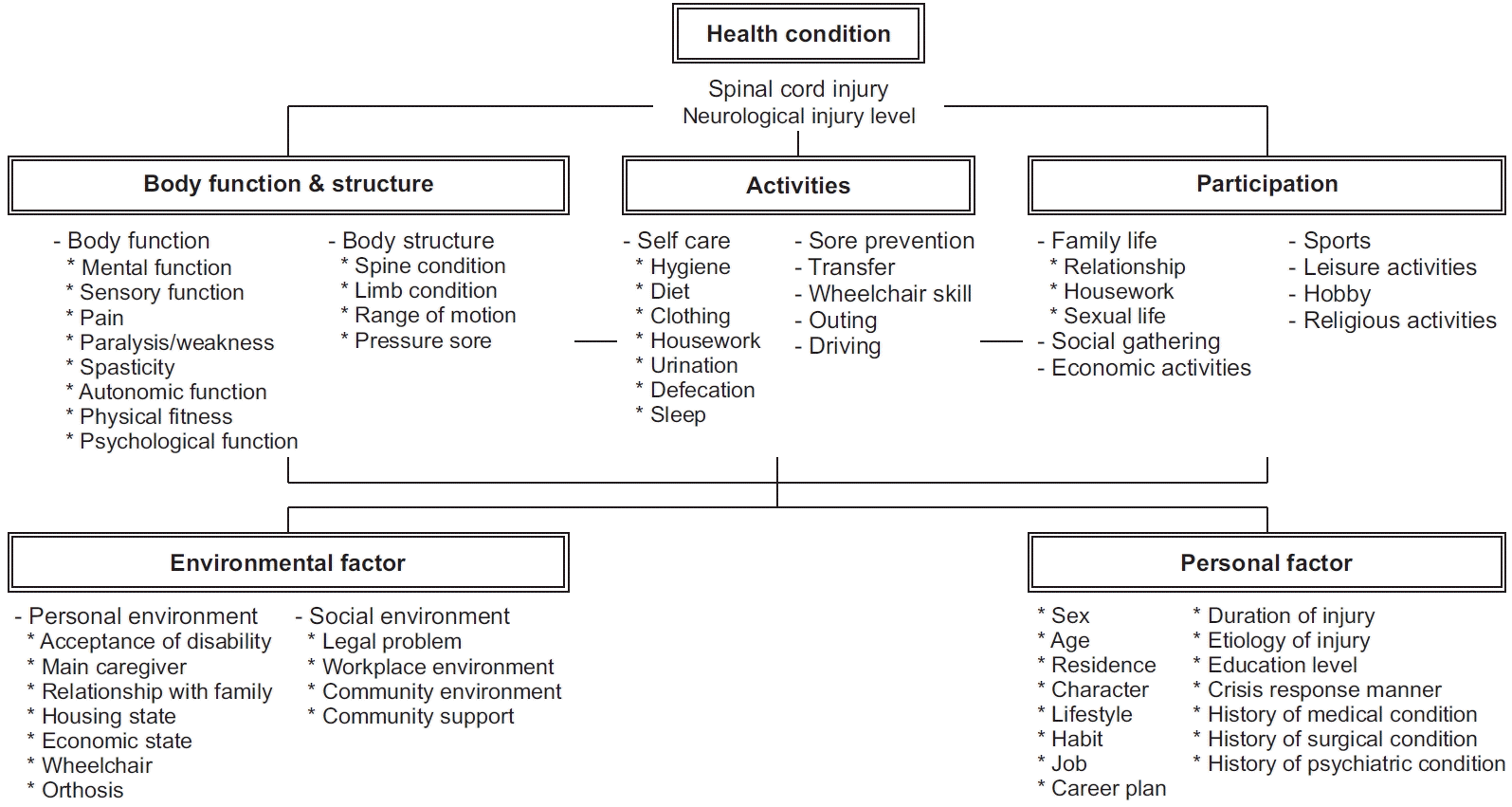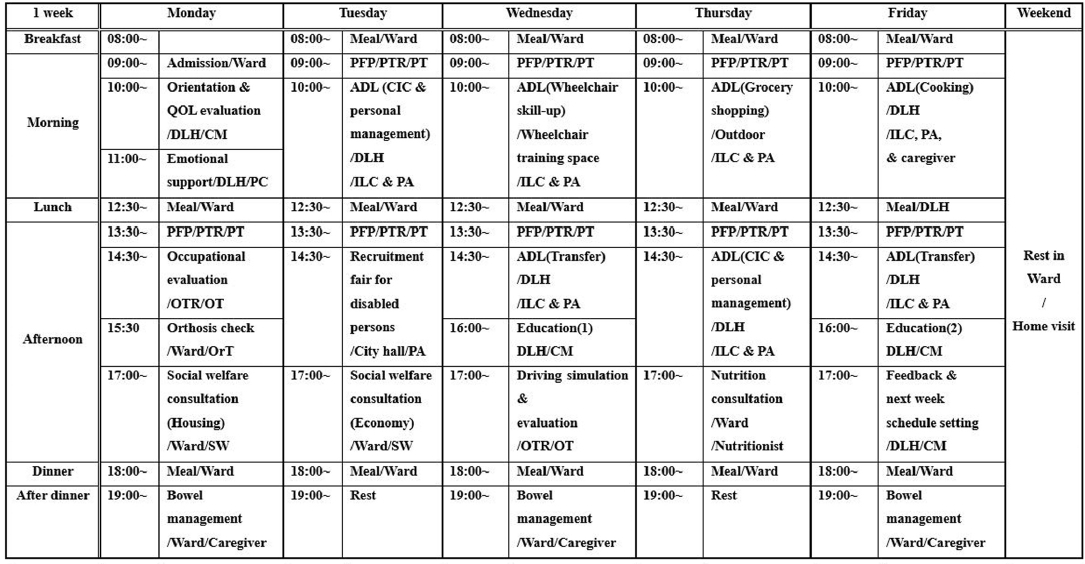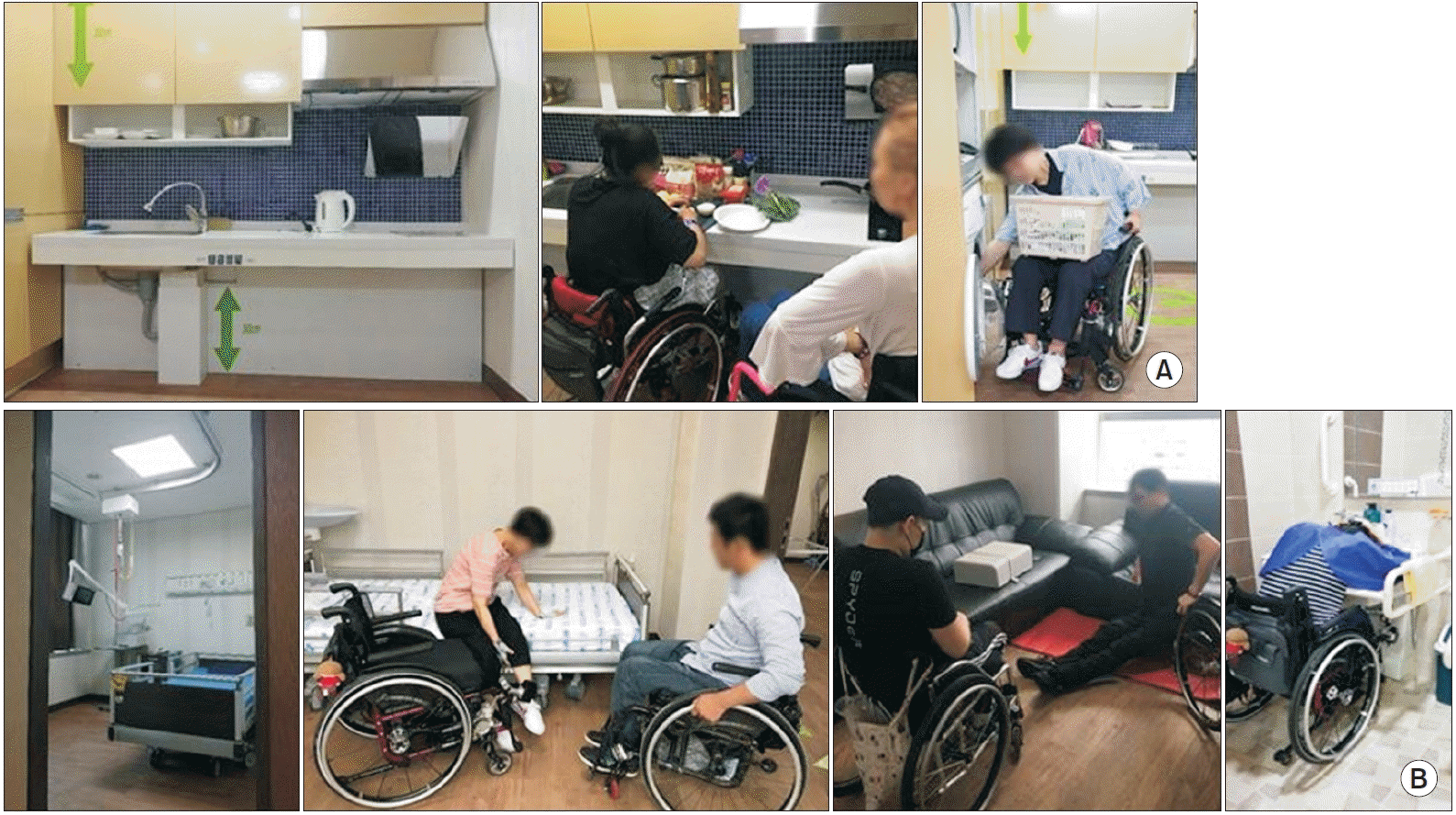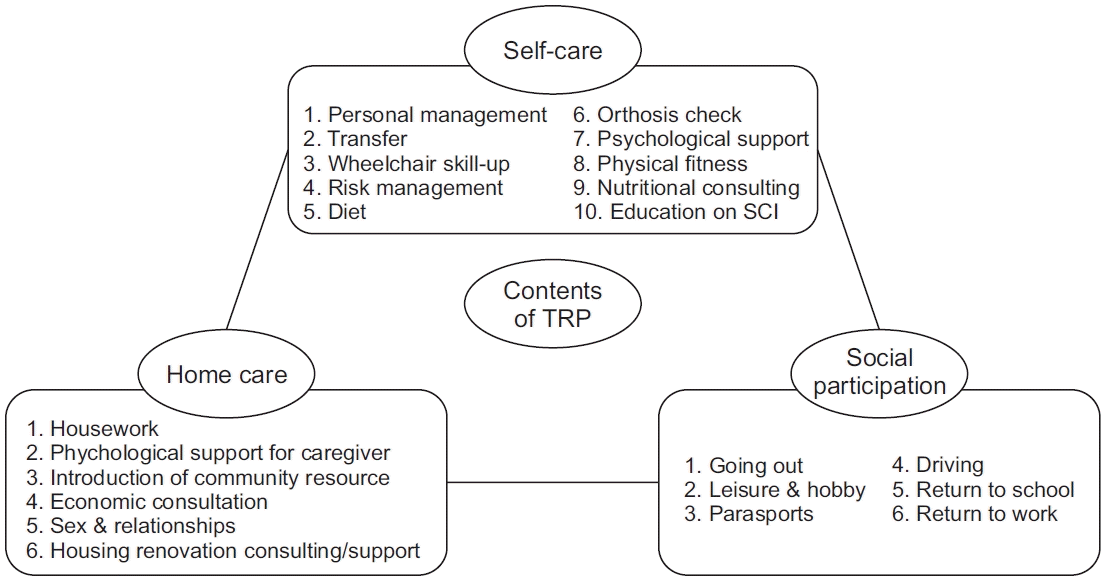INTRODUCTION
In the 2017 survey on the status of disabled individuals by the Ministry of Health and Welfare in Korea, the rate of spinal cord injury (SCI) was 3.5% among Koreans with physical disabilities, and there were at least 45,000 registered SCI patients. Since 99.2% of physical disabilities are acquired and 70.8% of these disabilities occur in individuals aged 20–65 years, a considerable number of SCI patients experience impairment during their active social life [
1]. It is known that distress, depression, and frustration due to a disability can have a huge impact on mental health; therefore, a careful, multidisciplinary approach must be implemented to assist SCI patients to return to society [
2,
3].
Data on the current status of SCI patients in Korea are scarce; nonetheless, the report published in 2018 by the Korea Spinal Cord Injury Association (KSCIA) revealed that 62.7% of cases were referred to more than three hospitals until discharge and that the average duration of inpatient treatment was 30.8 months [
4]. This is significantly longer than the data reported by SCI registries worldwide. In a 2018 New Zealand report, the average length of hospital stay from injury to discharge was 76.9 days, compared to 53.0 days in the United States between 2015 and 2020 [
5,
6]. This indicates the absence of an integrated rehabilitation system, from acute phase rehabilitation to return to society, despite the high level of medical care in Korea. It can be presumed that an extended hospital stay leads to unnecessary medical expenditure, dependency of SCI patients, and secondary family-related problems due to dysfunction in the household, resulting in social losses for individuals, families, and even the state.
In contrast, in other countries, the following three types of SCI rehabilitation systems exist: (1) national spinal injury centers, such as those seen in the UK and Switzerland, which provide treatment from the acute stage until the rehabilitation stage and ensure a smooth return to society, along with integrated follow-up management within a single national institution [
7,
8]; (2) SCI rehabilitation centers in accredited hospitals with completed certifications, such as the American Spinal Cord Injury Model System [
9]; and (3) supporting a smooth return to society through a transitional rehabilitation program (TRP) prepared during the period of discharge, which is implemented in Australia and New Zealand [
10,
11]. In any case, efforts are being made for SCI patients to achieve a quick and safe return to society through a multidisciplinary approach, with the intention of shortening the period of hospitalization and increasing the rate of home discharge [
5,
6].
In the present study, we developed the Korean version of a hospital-based TRP for SCI patients using daily living home (DLH), a space in the hospital where patients could be taught to perform the activities of daily living (ADL), and evaluated its effectiveness for SCI patients.
Go to :

DISCUSSION
This study was conducted to develop the Korean version of the hospital-based TRP using DLH and to evaluate its effectiveness for SCI patients’ successful discharge and smooth return to society. TRP, as an intermediate link between rehabilitation treatment in the hospital and life after discharge, was developed with the goal of buffering the secondary trauma experienced after discharge by experiencing the home and social environment that would have changed after SCI by maximizing functional ability and minimizing trial and error. Therefore, the big difference from conventional rehabilitation treatment is hard training for self-care (independent clean intermittent catheterization [CIC] technique, bathing, etc.), safe performance of indoor activities (cooking, washing, etc.) and outdoor activities (shopping, participating in para-sports, visiting homes of peer disabled persons, creating hobbies, using public transportation, etc.) with supervision and assistance by medical staff and ILCs.
Hospital-based TRP was developed through current status surveys of domestic and overseas institutions and FG meetings, following which improvement proposals were developed through feedback obtained from pilot applications, FG meetings, and Delphi surveys. Hospitalbased TRP, with an average duration of 21.8 days (16.5 days excluding weekends), was applied to four chronic SCI patients with an average injury duration of 736.8 days. As a result, K-SCIM, Seoul-IADL, COPM, RIC-FAS, K-WHOQOL-BREF, K-CIQ, and GAS showed statistically significant improvement. In particular, although subjects 1 and 5 had been receiving continuous inpatient rehabilitation after their injury for more than 2 years before the hospital-based TRP was implemented, they satisfied 72.1% (44/61) and 76.8% (53/69) of expected K-SCIM, respectively. Eventually, both achieved 100% of the expectation, and the achievement rate for the core goals evaluated through GAS also showed very high results. The average cost per subject was 7,494,502 Korean won, and the average cost of the strictly hospital-based-TRP was 2,446,647 Korean won.
Although there have been theoretical considerations for establishing the Korean Transitional Rehabilitation System Model, the present study is the first to plan, implement, and evaluate its effectiveness clinically [
17]. Although there have been cases in which the TRP was conducted at non-medical sites, including the KSCIA, the present study is the first to intensively carry out a hospital-based TRP within a short period [
12,
18,
19]. In the future, when improving the medical rehabilitation system and determining the related medical fee, it is expected that the present study will be of high value.
Several common important points were found through the current status survey of overseas rehabilitation systems implemented in the process of developing the hospital-based TRP [
7-
11,
14,
15,
20]. First, other countries have an integrated management system from acute treatment after injury to subacute rehabilitation and rehabilitation for a smooth return to society. In particular, it is important to actively engage patients with early mental interventions and peer support on a potential return to society when moving into an acute SCI ward or rehabilitation ward. Through this, it is possible to prevent the occurrence of learned lethargy in SCI patients. This can be considered one of the factors that can achieve successful early discharge within months after injury. In Korea, such an integrated system is not widely available after SCI, and patients and their caregivers have to go individually to rehabilitation hospitals, social rehabilitation procedures, community welfare institutions, and government agencies. It is expected that there are several cases of long-term hospitalization due to fear of returning home. Second, the rehabilitation system is operated by a multidisciplinary team, and third, peer support is important. There were several cases in which the peer disabled persons were members of medical institutions, and it is judged that presenting a visible role model to SCI patients increases the efficiency of preparing for discharge through the transfer of practical know-how and mental management by peer support. Fourth, there are professional personnel to support the rehabilitation of SCI patients; therefore, it is necessary to support a consistent rehabilitation process from the initial stage of SCI to follow-up management. In the UK, this role is played by are settlement officer or community coordinator, in the United States by a case manager, in New Zealand by an ILC, and in Sweden by a rehabilitation instructor. Typically, they are nurses, social workers, occupational therapists, or persons with SCI (people who have experienced a successful return to society after injury) and play a role as experts in supporting the return to society of SCI patients. Fifth, the local community care system for SCI patients is properly established. These points are very different from the current reality in Korea, and it seems to be why a rapid and safe return to society for SCI patients in Korea is not smoothly achieved.
As mentioned in the Introduction section, the hospital stay of SCI patients in Korea has been observed to be significantly extended, compared to that of SCI patients overseas [
4-
6]. In addition to medical factors, other cultural and social factors such as the completeness of community care and the payment system for medical expenses are considered to be complex. From a medical point of view, neurological recovery in general SCI patients is known to be within 2 months and, in 77% of cases, within 3 months after injury [
21,
22]. Depending on upper limb function, muscle strength has been reported to be rarely recovered until 2 years after injury [
23]. In the present study, in subject 1, the upper limb motor score increased from 44 at the initial stage to 46 after TRP, with a certain improvement in the grip strength, which was not enough to change AIS. Therefore, the level of neurological recovery in most SCI patients is determined, in most cases, at 3 to 12 months. Therefore, if the serial neurological evaluation shows a saturation pattern, efforts should be made to educate the patient to use residual function to the extreme and change the surrounding environment, including the caregiver, to suit the patient. For this reason, it is reasonable to consider increasing the proportion of hospital-based TRP in inpatient rehabilitation treatment or completely converting to hospital-based TRP at a certain point in time.
Of course, based on the evidence that it can take up to 2 years after injury before muscle strength is restored, the National Health Insurance system in Korea allows neurodevelopmental treatment to be conducted twice a day during hospitalization, for up to 2 years after onset [
23]. It is necessary to consider whether such a system may unnecessarily extend the length of hospital stay for the patient. The perception that patients can receive inpatient rehabilitation treatment for up to 2 years after injury onset is widespread among patients, and it is necessary to consider whether the discharge of SCI patients is delayed due to the formation of interest between consumers and suppliers of rehabilitation treatment. To solve this problem, it is necessary to refer to the Japanese convalescent hospital system. According to the information obtained by visiting the Kanagawa Rehabilitation Center in Japan, SCI patients are transferred from the acute stage hospital to the convalescent hospital within 2 months after SCI and receive rehabilitation treatment up to 5 months after injury. Rehabilitation treatment is partially supported by the National Health Insurance, and differential rates are applied to excellent institutions by evaluating the rate of return to the community, rate of long-term hospitalization, and characteristics such as severity and disease group. Based on the Japanese convalescent hospital system, an active rehabilitation system is in operation. Considering that the period is limited to 5 months after injury, rapid transfer from acute hospitals to convalescent hospitals is being achieved, and weekend rehabilitation treatment, home rehabilitation support, and advanced daily life training are thoroughly operated. In Korea, the “rehabilitation medical institution” pilot project kicked off in 2020. For SCI, the hospitalization period is set within 90 days after the onset/surgery, and the admission application period is 180 days. During this period, an integrated planning management fee (for patient management through multidisciplinary team meetings), an integrated rehabilitation functional evaluation fee (for periodic functional evaluation), and a fee per unit of treatment time are applied, and it is known that the fees are improved and newly established to support the patients’ smooth return to society [
24]. When this “rehabilitation medical institution” system is officially established, it is believed that applying the hospital-based TRP developed in this study will help patients return to society quickly and stably. Not only professional rehabilitation treatment conducted by medical staff but also TRP, such as programs along with ILC and psychological supporting program, are needed for institutionalization and establishment of related fees.
TRP programs may be implemented in hospitals or nonmedical areas such as the KSCIA; it is thought to be best if the first TRP after injury is based in a hospital [
12,
18,
19]. A representative example is urinary tract infection (UTI). In subjects 1 and 5 who participated in this study, they had never performed CIC independently, despite it being 730 days after injury. Self-CIC is very necessary for independent ADL. CIC training is conducted under the close guidance of a specialized nurse and ILC; however, if both subjects have a UTI, they have to proceed with concurrent TRP and antibiotic treatment. Moreover, if TRP is performed for subacute SCI patients, there is a possibility of medical or surgical problems. Therefore, it is believed that the initial TRP program should be conducted before discharge based on the hospital.
As indicated in
Table 5, some costs were incurred in the TRP operation. The average cost per TRP of one subject was 7,494,502 Korean won, of which 32.6% was used for the pure TRP operation, and 21.5% was the wage of a researcher who was hired for this study and served as a program assistant, and 88.7% of the pure TRP operating costs were the service costs for ILC. The cost related to the activities of the case manager, such as in-depth interviews and goal-setting meetings, could not be set because there was no relevant fee. Although a certain cost is incurred for TRP operation, if the average length of hospital stay for domestic SCI patients can be reduced to 30.8 months within a year or 3–6 months with stable settlement, unnecessary national and individual medical expenses can be drastically reduced [
4].
Looking deeper into the hospital-based TRP developed in this study, hospital-based DLH should be configured as similar to the home environment as possible so that daily life training, such as cooking, housekeeping, transfer education, and excessively advanced facilities, can be avoided to enable realistic training for the subject. In addition to the components of indoor facilities, it is necessary to form a network with outdoor facilities, such as courses that enable wheelchair technology promotion training, and facilities outside medical institutions, such as shopping and leisure experiences. An ILC, a peer SCI person who has achieved a successful return to society, is a member of the multidisciplinary team that plays an important role in TRP. Because they are not healthcare professionals from health authorities, if TRP becomes institutionalized in the future, verification processes may be needed for ILCs, which could be done through a regular curriculum and qualifications through the KSCIA. Additionally, for SCI patients, it is necessary to secure a number of ILCs because SCI patients’ functioning can be very diverse in consideration of sex and NLI. Additionally, under the current system, it is not possible to apply for an activity assistant supported by the authorities when admitted to a hospital. However, for the successful settlement of daily life after discharge, it is also worth considering that SCI patients and their activity assistants, to be assigned after discharge, need the time to adjust by allowing them to participate in the hospital-based TRP.
There exists no internationally accepted standard for the TRP duration; however, in Burwood Hospital in New Zealand, which operates a hostel, the admission period is designated as 1 month [
11]. In the Australian TRP, which is conducted at the subject’s home, the program is operated for a flexible period of 2–8 weeks; however, direct comparison is difficult because most of the daily life training is sufficiently performed in the SCI ward before discharge [
10,
25]. A 2016 study indicated that a lower initial daily living ability evaluation score is associated with a longer program period. Moreover, the degree of satisfaction at the end of the program was proportional to program duration. However, there was no significant relationship between performance improvement and program duration [
26]. Considering economic feasibility, excessively long program periods should be avoided. Based on 4 weeks, the operation may be adjusted to 2–4 weeks for paraplegia and 3–5 weeks for tetraplegia.
Study limitations
The present study has some limitations. First, this study was applied to a small number of subjects in a single institution. As suggested in this study, a considerable cost is incurred for TRP operation per patient, and large-scale research has limitations of research funding. In the future, further studies conducted in multiple institutions and involving several subjects are necessary to verify the effectiveness and stability of the hospital-based TRP.
In this study, the TRP was developed for spinal cord-impaired patients with lower cervical and thoracic SCI and relatively preserved upper limb function. It is necessary to develop a program for patients with upper cervical SCI through additional studies.
Furthermore, it was confirmed that the subjects maintained their functional improvement and return-to-society status (deinstitutionalization, participation in social activities, and return to school) 1 month after completion; however, long-term monitoring was not conducted because of the limited study period. In Australia, the Spinal Outreach Team systematically monitors those who participated in the social rehabilitation program for up to 12 months and provides early intervention and advice [
10]. In New Zealand, outreach nurses visit and continuously monitor patients through phone calls after TRP, and at the end of 6 months, the patients are re-hospitalized for 3 days, and physical, occupational, social welfare, and psychological evaluation, including neurological and urodynamic tests, are performed. In the future, through additional research, it is necessary to formulate a follow-up management plan after hospital-based TRP.
In conclusion, the Korean version of the hospital-based TRP, applied to chronic SCI patients, it was thought that there is a possibility of improving the patients’ functioning and QOL, and appeared to be effective in successful discharge and social participation. Through this, it is considered that the inclusion of hospital-based TRP is necessary in the future when constructing a comprehensive rehabilitation system from SCI to return to society.
Go to :







 PDF
PDF Citation
Citation Print
Print






 XML Download
XML Download